Cavalrymen willy-nilly. History of the H 35 and H 39 tanks
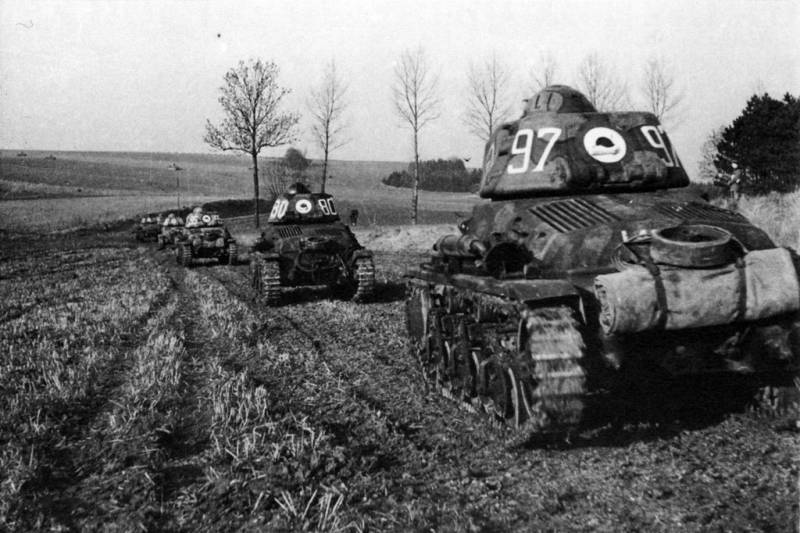
Column H 35 in the Ardennes, May 1940
We don't know well history French armored vehicles. Or rather, the main “characters” are well known to us - these are Tanks and armored cars Hotchkiss, Saumua, Panhard and so on. But what kind of machines are these, why were they created and under what conditions? How were the French going to fight against them? All these questions have long been shrouded in myths.
In this article we will look at the history of the H 35 and H 39 tanks from Hotchkiss. By themselves, they are hardly interesting - ordinary cheap cars, perhaps with good armor. It is much more interesting for us to dispel the myths about these tanks. The canonical story of H 35 and H 39 is so grossly at odds with the facts that you can’t help but wonder: how could they even come up with it? In addition, Hotchkiss tanks left an important mark. It was the Hotchkiss company that first proposed making cast tanks, and at the same time stirred up the French tank program. This is what we will talk about today.
Timely offer
By the beginning of World War II, French tank forces were second only to Soviet tank forces. But we must take into account that the French built most of the modern tanks in 1936-1940, preparing for the battle with Nazi Germany. And in the early 30s, the basis of the French tank fleet was three and a half thousand hopelessly outdated Renault FTs. What could replace them? Renault launched production of the D1 light tank, but the army quickly became disillusioned with it.
Renault designers tried to make the design as cheap as possible, so the D1 suffered from poor quality and constant breakdowns. In addition, in 1932 it was the only modern tank in France, too valuable for banal infantry support. At first, the D1s served as battle tanks (char de bataille), since the “real” B1 battle tank went into production only in 1934. So it turned out that there was nothing to replace the antique Renault FT with.
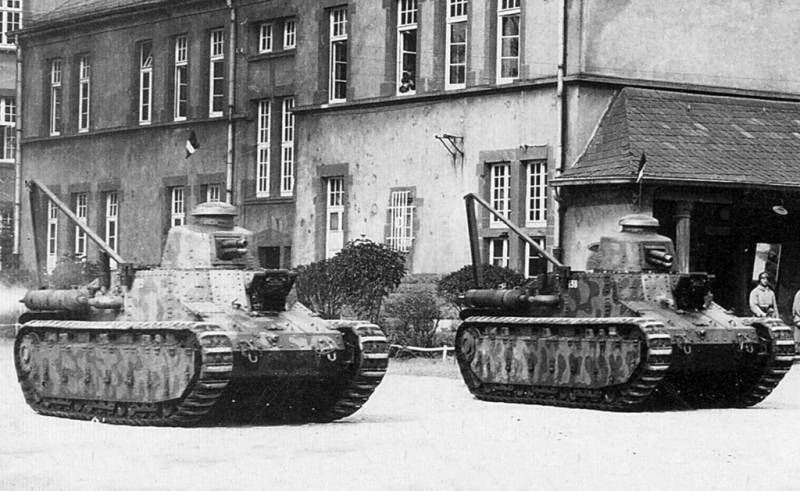
Char D1 on maneuvers in Champagne, 1935. At first they were equipped with turrets from Renault FT
Seeing the difficult situation, the Hotchkiss company took the initiative and in 1933 itself proposed a new tank concept to the military. It was a small two-seater vehicle weighing 6 tons, very simple and cheap. For the first time, the tank hull was assembled from large cast parts with bolts. The layout was atypical for the French, with the engine in the rear and transmission in the front. To reduce the cost, they even abandoned the turret, placing two machine guns in the hull, so the tank was very reminiscent of the “fattened” British Carden-Loyd wedge. It must be said that the Hotchkiss company was led by the Englishman Henry Mann Ainsworth, who moved from the British branch.
The military supported the proposal, because they finally saw a truly massive replacement for the Renault FT. On June 30, 1933, Hotchkiss received a contract to build three prototypes, and a competition was announced on August 2. In many ways, he repeated Ainsworth's proposal: a simple and reliable tank weighing 6 tons with 30 mm armor and armament with two machine guns or a 37 mm cannon in the turret.
Competition with Renault
In total, 14 companies took part in the competition for the light tank. In addition to Hotchkiss, we are interested in two of them - Renault and APX (short for Atelier de construction de Puteaux - engineering plant in Puteaux). Renault was the fastest to cope; its prototype Renault ZM was ready for testing in December 1934. It was a tank weighing 7,5 tons, with an 82 hp engine. With. and a turret with two machine guns. He did not cause delight among the military. The engineers squeezed the armor volume to the limit, so the fighting compartment turned out to be very cramped, and the ammunition load and fuel supply were insufficient. But even so it turned out to be impossible to fit into 6 tons.
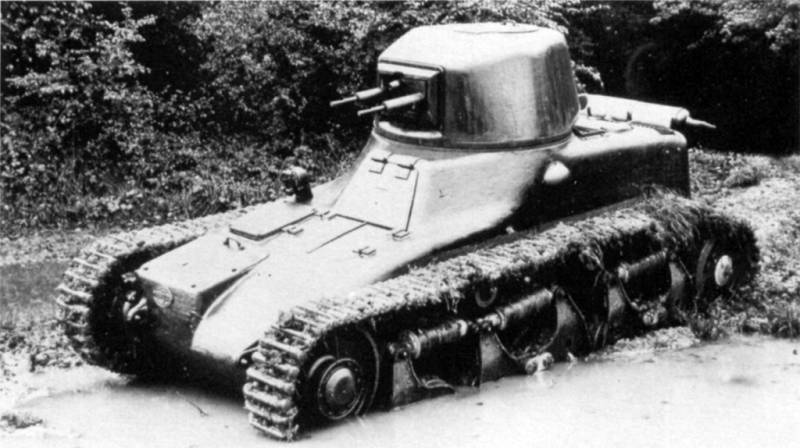
First prototype of Renault ZM. The usual R 35 is still very far away
Hotchkiss built the first prototype in January 1935. It weighed 8,5 tons and was powered by a less powerful 78 hp engine. With. and in addition did not have a tower. In general, compared to its competitor, the heavier and less armed Hotchkiss tank looked pale. This is not surprising. Renault took advantage of the developments on its AMR 33 cavalry tanks. The engine, transmission and suspension on rubber washers were tested on AMR 33 prototypes. In terms of the general layout and design of the chassis, the Renault ZM was very similar to the future AMR 35. But Hotchkiss had no experience in tank building in general, so the engineers had to create the project from scratch. Needless to say, their first pancake turned out to be lumpy.
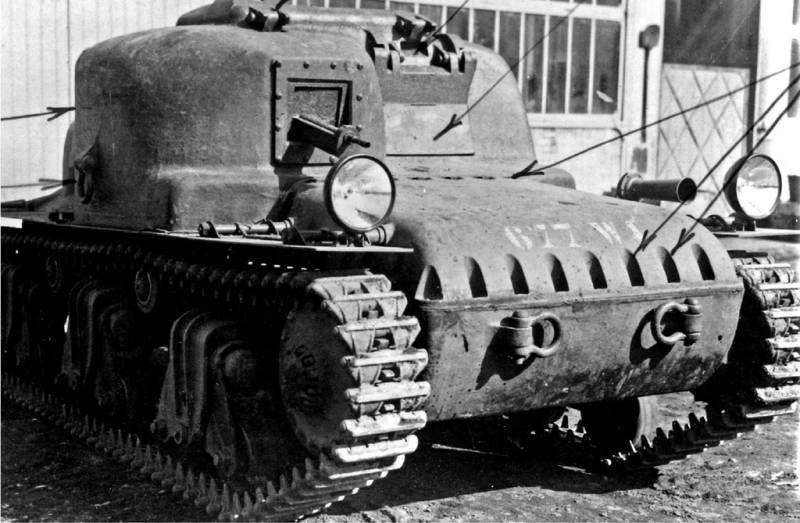
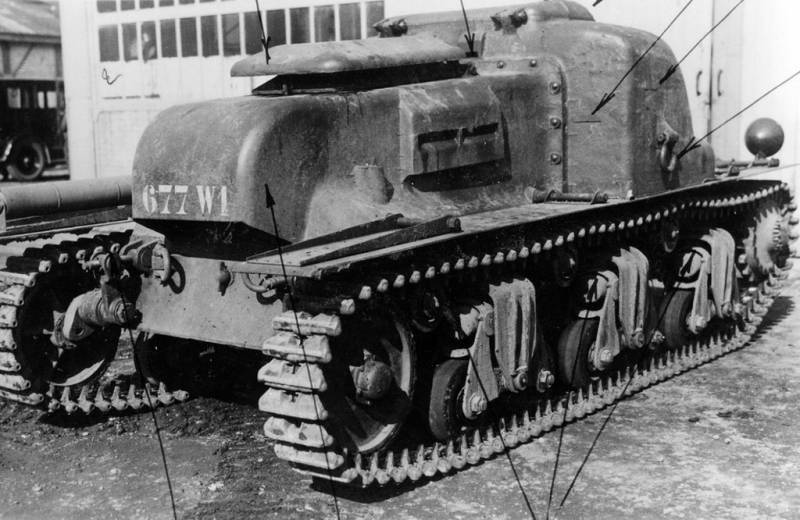
The first two Hotchkiss prototypes did not have turrets. They looked... very peculiar
However, no matter how the Hotchkiss and Renault tanks turned out, they could not get into mass production. The fact is that in 1934 the French army adopted the Hotchkiss 25 mm anti-tank gun. The gun turned out to be very light and compact, but at the same time easily penetrated 30 mm armor. The French understood that similar guns would appear en masse in other armies, so they decided to strengthen the armor of the new tanks to 40 mm. At the same time, the weapons were revised - now a 37-mm cannon in the turret became mandatory.
In order not to waste time, the companies built the first tanks according to the old instructions, reworking the projects on the fly, taking into account the tests. And here is the time to remember the APX tank. Apparently, it was the world's first tank with a two-stroke diesel engine. No photographs of it have survived, although it is known that a prototype was built by October 1935. The tank itself was not needed by the military, but its turret was considered successful. It was installed on converted Hotchkiss and Renault tanks.
In general, the familiar H 35 and R 35 did not appear immediately. After all the changes, they “grew fat” to 10-11 tons, and the improved H 39 even grew to 12 tons - twice the original requirements.
Fresh legend, but hard to believe
Usually the situation with the competition for a light infantry tank is described as follows. The Hotchkiss and Renault offerings were very similar in features and prices. The Hotchkiss tank was faster (by almost a third) and therefore looked better, but the infantry rushed to choose the Renault tank. Or maybe they helped her “hurry up”? In any case, the Hotchkiss company withdrew from the infantry competition and successfully added its faster tank to the cavalry competition. This is roughly how the canonical history of the H 35 and R 35 developed.
It's amazing that such a stupid version of events could arise and be maintained for decades. Let's start with mobility. The Hotchkiss tank's faster speed claim is purely based on a numbers game. The H 35 was equipped with a five-speed gearbox, which provided an estimated top speed of 28 km/h. The R 35 only had a four-speed gearbox and an estimated top speed of 20 km/h. It would seem that the superiority in speed is obvious. But it's not that simple.
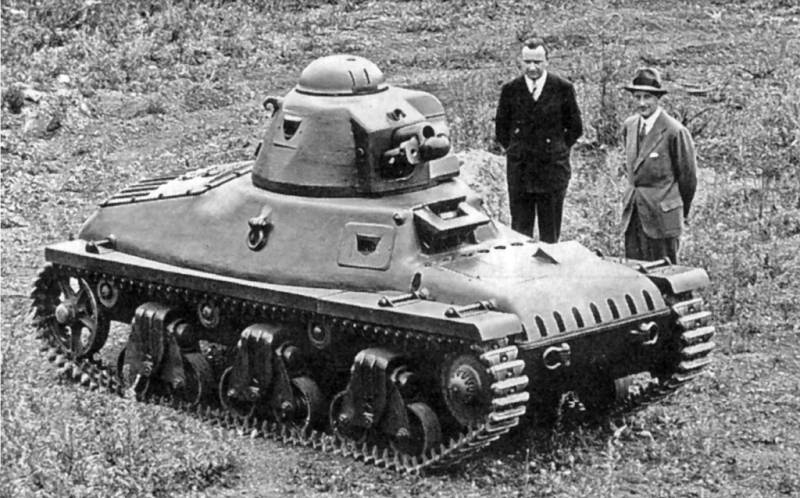
The third Hotchkiss prototype received an early APX turret. The appearance is recognizable, although in detail it differs in many respects from production cars
The estimated maximum speed is calculated based on the diameter of the drive wheels, maximum engine speed and minimum transmission ratio. In other words, this is not a recorded test result, but just a number on paper. It reflects the maximum speed that the transmission provides. In practice, the maximum speed depends not only on the gearbox, but also on the engine. If there is not enough power, the tank will not be able to reach the designed speed.
The higher design speed was an advantage only on paper. The H 35 weighed a ton more, and its engine was weaker - 78 hp. With. versus 82 hp With. from Renault. Both tanks are comparable in weight and engine power, which is why their actual average speeds are similar. In addition, the H 35 was less protected and simply did not meet the requirements. The thickness of the armor of its hull did not exceed 34 mm versus an honest 40 mm for the R 35. Increased protection would lead to an increase in mass, and here everything rested on a weaker engine. It turns out that the supposedly similar and more mobile H 35 turned out to be neither similar nor more mobile.
Forcedly necessary
If we put aside the mythical superiority of the H 35, then the choice of the French infantry becomes quite reasonable. The military understood perfectly well that the R 35 was a rather mediocre tank. It did not cope well with off-road conditions, because its chassis was designed to weigh 6-7 tons. However, the French army urgently needed a mass-produced cheap tank; there was simply no time for serious modifications. Unlike the bastard D1, at least the R 35 didn't fall apart at every corner. Its competitor, Hotchkiss, did not meet the requirements and turned out to be even more mediocre.
During testing, the H 35s proved to be very crude machines. The military complained of frequent breakdowns, weak brakes and a poor differential steering mechanism that made the tanks difficult to handle off-road. The chassis as a whole turned out to be good, but the rubber tires on the rollers wore out quickly. Finally, the engine was too underpowered. Under other circumstances, the Hotchkiss company would have limited itself to building a few experimental vehicles, but its tank still went into mass production.

AC 3 prototype from SOMUA in the summer of 1935. It will go into production under the designation S 35. Comparing this powerful tank with the H 35 was a misunderstanding
Defense Minister Jean Fabry attended the display of the H 35 and S 35 prototypes. By coincidence, the Hotchkiss tank proved to be more agile, so the minister, not versed in technology, concluded that the more expensive S 35 had no special advantages. Cavalry General Jean Flavigny recalled:
Based on the results of the comparison, at the meeting it was decided to order Saumya, but what to do with Hotchkiss, whom the minister and his retinue liked so much? <...> General Gamelin decided to transfer Hotchkiss to the cavalry, even if he did not meet our requirements at all. <...> I could not refuse this “gift”, it was not very pleasant, however, I had a shortage of armored vehicles. At the same time, I gave a special opinion that upon completion of the formation of the mechanized divisions, they should be completely transferred to Saumua. Unfortunately, the low production rate did not allow us to obtain homogeneous units at Saumua.”
These memories well reflect the difficult situation of those years. The S 35 met the latest requirements and was technically advanced, but the SOMUA plant could not quickly produce enough of these expensive cars. And with mass-produced cheap tanks, things were going very poorly for the cavalrymen - the “cardboard” AMR 33 from Renault constantly broke down and quickly became outdated. In such conditions, the Hotchkiss tank with some kind of armor looked quite useless. It is usually said that the H 35 was more suitable for cavalry, but it is better to say that it was less unsuitable in this role. Cavalrymen, more often than infantry, relied on a network of good roads, so its shortcomings were not so noticeable.
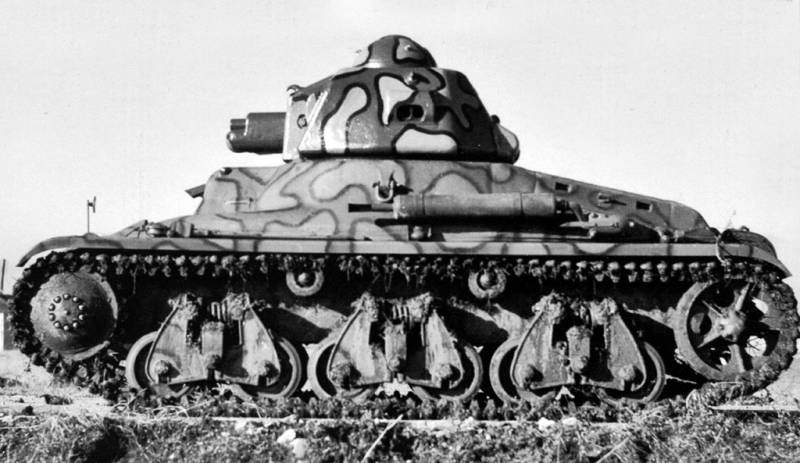
Serial N 35 with an early APX turret. It is issued by so-called diascopes - observation devices with two viewing glasses. Later they will be replaced with regular viewing slots
On November 6, 1935, Hotchkiss received the first contract for 200 H 35s for the cavalry. It was followed by a second contract for another 100 vehicles. The cavalrymen received the new tank very coolly; by their standards, it was too slow and unreliable. After fulfilling the cavalry contracts, Hotchkiss received a third order for 100 H 35s, this time for infantry. This decision was also forced. The Renault and FCM factories could not supply the required number of infantry tanks, so Hotchkiss' production capacity was needed like air. Inspector General of Infantry Julien Dufieux fought off the H 35 with all his might, but after the cavalrymen he had to come to terms.
So, behind the fabulous stories about the wise choice of cavalrymen and the infantry coming to their senses, there is a banal fact hidden. Minister Jean Fabry and Commander-in-Chief Maurice Gamelin literally forced the infantry and cavalry to accept a crude tank that they never wanted.
Some errors
Hotchkiss realized that the H 35 was a mediocre tank and needed to be redesigned. First of all, this concerned the power plant. And here the engineers came in handy with their work on Hotchkiss racing cars, which won the Monte Carlo Rally more than once. In 1937, a 35 hp racing engine was tested on the H 117. With. The tank became noticeably more mobile, but the transmission could not withstand the higher torque. Major design changes were required.
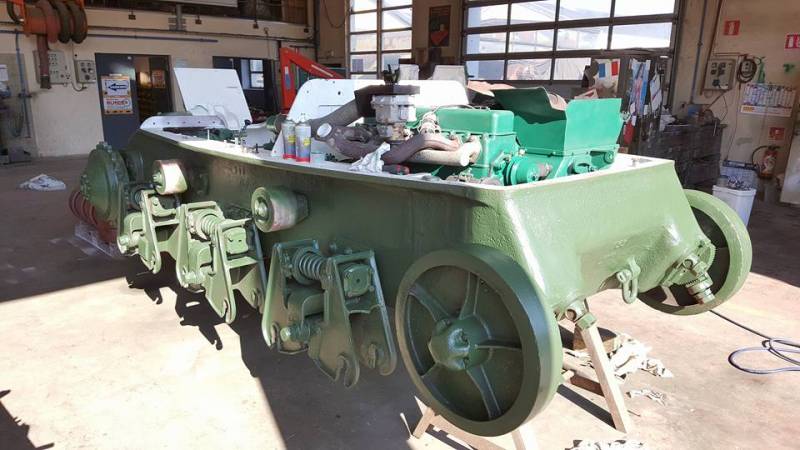
The rich interior of H 39 from the museum in Saumur. The cast body consisted of several large parts and could be disassembled like a construction set
In 1938, Hotchkiss introduced a new model, the H 35. The main difference was a 120-horsepower engine based on a racing engine. To install it, the aft part was noticeably enlarged, at the same time increasing the fuel supply from 180 to 207 liters. The armor thickness was brought to the required 40 mm, and the transmission was also improved. As a result, the weight of the tank increased to 12 tons, so the engineers abandoned rubber bands and widened the tracks by 2 cm. Tests showed that the new tank turned out much better than the old one. The maximum speed has increased to 36,5 km/h, while driving has become much easier. True, the new engine turned out to be quite voracious. According to German data, the SOMUA S 35 consumed 225 liters per 100 km on roads, and the much lighter Hotchkiss was not much less - 190 liters. Therefore, despite the increase in the fuel tank, the range was reduced from 150 to 120 km.
The new model was adopted on February 18, 1939 as the Char léger modèle 1935 H modifié 1939. Its name is usually abbreviated to H 39, but sometimes you can find the designation H 38. Confusion arose due to the fact that, before adoption, Hotchkiss called the new model Char léger modèle 1938 série D. Like its predecessor, the H 39 was supplied to both infantry and cavalry, with the infantry now being the main customer.
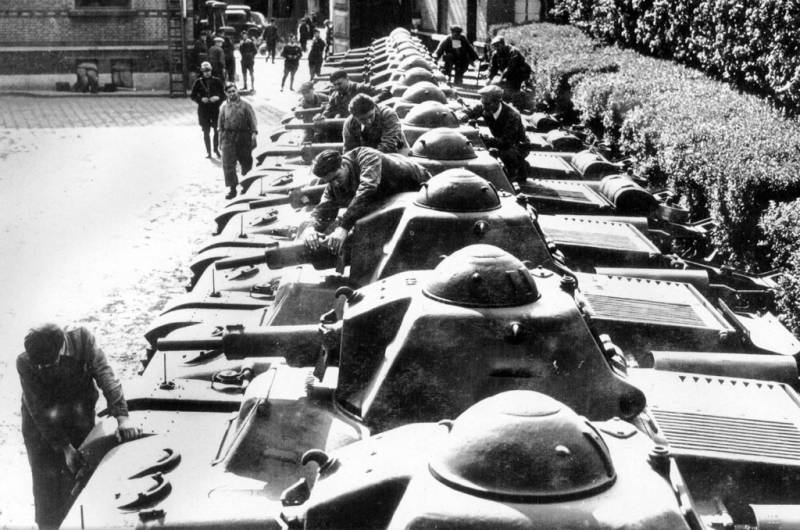
Delivery of batch H 39 in the spring of 1940. The tanks are equipped with tails and SA 38 cannons
In 1940, a program to modernize light tanks began. Like the R 35, the H 35 and H 39 were initially equipped with very weak, antediluvian SA 18 37 mm cannons. Some of these guns were simply removed from used Renault FTs in order to save money. At the end of 1939, the French mastered the production of a new SA 38 cannon of the same caliber, but much more powerful. In total, they managed to fire 800 guns, so there weren’t enough for all the tanks. In addition, many H 39s received a tail to overcome trenches; a spare wheel and a spare parts box were attached to it. And command vehicles were even equipped with radio stations. Overall, these were the most balanced and combat-ready light tanks in France.
From the worst to the best
The reader might get the impression that the Hotchkiss tank venture was a failure from the very beginning. They say that engineers with no experience proposed a useless tank, and Fabry and Gamelin imposed it on dissatisfied military personnel. This is wrong. To clear up some misconceptions, we've deliberately taken a very critical look at history. Now let’s give the characters in our story their due.
General Maurice Gamelin was one of the most intelligent and respected military men of his time. From 1933, he led the reorganization of the French army, preparing it for war. Despite his advanced age, Gamelin was an ardent supporter of mechanization. It was not at all easy to carry it out. France was significantly inferior to Germany in terms of population and industrial potential. Due to the economic crisis, there was a severe shortage of money, in addition, the leftist government of Leon Blum pursued dubious policies. In such conditions, compromises had to be made.
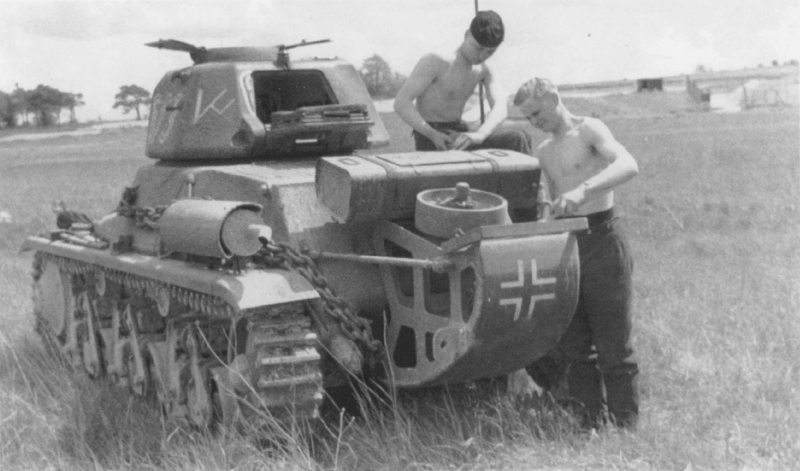
H 39 in German service. The tank has a characteristic tail with a box and a spare roller. The Germans cut off the tower's dome and added a double-leaf hatch. The French didn't like the dome idea either.
The H 35 was poorly suited to the role of a cavalry tank. But although Fabri was mistaken, his decision ultimately turned out to be correct. To equip three mechanized light divisions (division légère mécanique, abbreviated as DLM), similar to the German tank divisions, 600 S 35s were required. However, before the end of the war, the SOMUA plant managed to assemble 427 tanks. What could replace them? Renault was disrupting delivery plans, plunging into financial disaster. Its cavalry tanks AMR 35 and AMC 35 turned out to be very unsuccessful and constantly broke down. In just two years, the Hotchkiss company assembled almost 300 tanks for the new cavalry divisions. Compared to the AMR 35, even the H 35 was the standard of reliability.
The infantry also had problems. Renault factories could not assemble enough R 35s in a reasonable time. The promising FCM 36 was produced in a small series of only 100 tanks. The FCM company charged too high a price, and its capacity was spent on the Char B1 program. Once again, Hotchkiss helped fill the armor shortage. As a result, its tanks became the second most numerous after the R 35. And although the early H 35s were unsuccessful, the H 39s turned out to be much better than their competitors. It is significant that of all the captured French tanks, the Germans preferred the H 39 and S 35. Not bad at all for a company that had not worked on tanks at all before the H 35.
Sources:
* Steven J. Zaloga. French Tanks of World War II (1). Infantry and Battle Tanks
* Yuri Pasholok. Rejected by the infantry, attracted by the cavalry (https://warspot.ru/11331-otvergnutye-pehotoy-priglyanuvshiesya-kavalerii)
*GBM Magazine
* Panzer Tracts No. 19-1. Beute-Panzerkampfwagen
Information